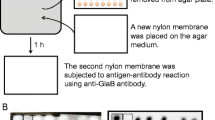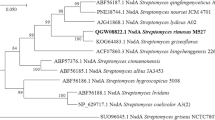Abstract
The Streptomyces virginiae γ-butyrolactone autoregulator virginiae butanolide is a low-molecular-weight Streptomyces hormone eliciting virginiamycin biosynthesis through its binding to the specific receptor protein, BarA. Immediately downstream of barA lies barB, the transcription of which is tightly repressed by BarA in the absence of virginiae butanolide and derepressed in its presence. Thus, BarB is next to BarA on the virginiae butanolide-BarA signaling cascade. An in-frame 279-bp deletion was introduced into the barB allele, which rendered it inactive by eliminating the majority of the coding region, including the helix-turn-helix DNA-binding motif. No significant change was observed with the ΔbarB mutant with respect to the timing or amount of virginiae butanolide production, or the morphological differentiation on solid media, indicating that barB neither participates in virginiae butanolide biosynthesis nor in cytodifferentiation. In contrast, analysis of virginiamycin production in the ΔbarB mutant revealed that production of both virginiamycin M1 and virginiamycin S occurred immediately after virginiae butanolide production, 2–3 h earlier than in the wild-type strain, indicating that BarB participates in the temporal retardation of virginiamycin production after virginiae butanolide inactivates the repressor function of BarA. RT-PCR analysis of the transcription of several genes surrounding barA–barB by the ΔbarB mutant indicated that BarB plays a negative regulatory role, directly or indirectly, in the transcription of barZ, vmsR, and orf5 located upstream of barB.





Similar content being viewed by others
References
Chater KF, Hopwood DA (1993) Streptomyces. In: Sonenshein AL, Hoch JA, Losick R (ed), Bacillus subtilis and other gram-positive bacteria. American Society for Microbiology, Washington, DC, pp 83–99
Hanahan D, Jessee J, Bloom FR (1991) Plasmid transformation of Escherichia coli and other bacteria. Methods Enzymol 204:63–113
He M, Kaderdhai MA, Adcock I, Austen BM (1991) An improved and rapid procedure for isolating RNA-free Escherichia coli plasmid DNA. Genet Anal Tech Applic 8:107–110
Hopwood DA, Bibb MJ, Charter KF, Kieser T, Bruton CJ, Kieser HM, Lydiate DJ, Smith CP, Ward JM, Schrempf H (1985) Genetic manipulation of Streptomyces: a laboratory manual. The John Innes Foundation, Norwich, UK
Kawachi R, Nihira T, Yamada Y (1997) Development of a transformation system in Streptomyces virginiae. Actinomycetologica 11:46–53
Kawachi R, Akashi T, Kamitani Y, Sy A, Wangchaisoonthorn U, Nihira T, Yamada Y (2000a) Identification of an AfsA homologue (BarX) from Streptomyces virginiae as a pleiotropic regulator controlling autoregulator biosynthesis, virginiamycin biosynthesis and virginiamycin M1 resistance. Mol Microbiol 35:1–13
Kawachi R, Wangchaisoonthorn U, Nihira T, Yamada Y (2000b) Identification by gene deletion analysis of a regulator, VmsR, that controls virginiamycin biosynthesis in Streptomyces virginiae. J Bacteriol 182:6259–6263
Kinoshita H, Ipposhi H, Okamoto S, Nakano H, Nihira T, Yamada Y (1997) Butyrolactone autoregulator receptor protein (BarA) as a transcriptional regulator in Streptomyces virginiae. J Bacteriol 179:6986–6993
Kinoshita H, Tsuji T, Ipposhi H, Nihira T, Yamada Y (1999) Characterization of binding sequences for butyrolactone autoregulator receptors in Streptomycetes. J Bacteriol 181:5075-5080
Kondo K, Higuchi Y, Sakuda S, Nihira T, Yamada Y (1989) New virginiae butanolides from Streptomyces virginiae. J Antibiot 42:1873–1876
Lee C-K, Minami M, Sakuda S, Nihira T, Yamada Y (1996) Stereospecific reduction of virginiamycin M1 as the virginiamycin resistance pathway in Streptomyces virginiae. Antimicrob Agents Chemother 40:595-601
Lee C-K, Kamitani Y, Nihira T, Yamada Y (1999) Identification and in vivo functional analysis of a virginiamycin S resistance gene (varS) from Streptomyces virginiae. J Bacteriol 181:3293–3297
Nakano H, Takehara E, Nihira T, Yamada Y (1998) Gene replacement analysis of the Streptomyces virginiae barA gene encoding the butyrolactone autoregulator receptor reveals that BarA acts as a repressor in virginiamycin biosynthesis. J Bacteriol 180:3317–3322
Nakano H, Lee C-K, Nihira T, Yamada Y (2000) A null mutant of the Streptomyces virginiae barA gene encoding a butyrolactone autoregulator and its phenotypic and transcriptional analysis. J Biosci Bioeng 90:204–207
Namwat W, Lee C-K, Kinoshita H, Yamada Y, Nihira T (2001) Identification of the varR gene as a transcriptional regulator of virginiamycin S resistance in Streptomyces virginiae. J Bacteriol 183:2025–2031
Nihira T (2003) Virginiamycin: biosynthetic pathway and its regulation, with special emphasis on the genetic aspects and autoregulator-dependent regulation. In: Fierro F, Martin JF (eds) Microbial secondary metabolites: biosynthesis, genetics and regulation. Research Signpost, Leon
Nihira T, Shimizu Y, Kim HS, Yamada Y (1988) Structure-activity relationships of virginiae butanolide C, an inducer of virginiamycin production in Streptomyces virginiae. J Antibiot 41:1828–1837
Okamoto S, Nakamura, K, Nihira, T, Yamada, Y (1995) Virginiae butanolide binding protein from Streptomyces virginiae. J Biol Chem 270: 12319–12326
Sambrook J, Fritsch EF, Maniatis T (1989) Molecular cloning: a laboratory manual, 2nd edn. Cold Spring Harbor Laboratory, Cold Spring Harbor, New York
Sato K, Nihira T, Sakuda S, Yanagimoto M, Yamada Y (1989) Isolation and structure of a new butyrolactone autoregulator from Streptomyces sp FRI-5. J Ferment Bioeng 68:170–173
Stratigopoulos G, Cundliffe E (2002a) Expression analysis of the tylosin-biosynthetic gene cluster: pivotal regulatory role of the tylQ product. Chem Biol 9:71–78
Stratigopoulos G, Gandecha AR, Cundliffe E (2002b) Regulation of tylosin production and morphological differentiation in Streptomyces fradiae by TylP, a deduced γ-butyrolactone receptor. Mol Microbiol 45:735–744
Wehmeier UF (1995) New multifunctional Escherichia coli-Streptomyces shuttle vectors allowing blue-white screening on Xgal plates. Gene 165:149–150
Yamada Y, Nihira T (1998) Microbial hormones and microbial chemical ecology, p377–413. In: Barton, DHR, Nakanishi K, Meto-Cohn O (eds), Comprehensive natural products chemistry, vol 8, Elsevier, Oxford
Yamada Y, Sugamura K, Kondo K, Yanagimoto M, Okada H (1987) The structure of inducing factors for virginiamycin production in Streptomyces virginiae. J Antibiot 40:496–504
Yanagimoto M (1983) Novel actions of inducer in staphylomycin production by Streptomyces virginiae. J Ferment Technol 61:443–448
Yang K, Han L, Vining, LC (1995) Regulation of jadmycin B production in Streptomyces venezuelae ISP5230: involvement of a repressor gene, jadR 2 . J Bacteriol 177:6111–6117
Yang YK, Shimizu H, Shioya S, Suga K, Nihira T, Yamada Y (1995) Optimum autoregulator addition strategy for maximum virginiamycin production in batch culture of Streptomyces virginiae. Biotechnol Bioeng 46:437–442
Yanisch-Perron C, Vieira J, Messing J (1985) Improved M13 phage cloning vectors and host strains: nucleotide sequences of the M13mp18 and pUC19 vectors. Gene 33:103–1219
Acknowledgements
This work was supported in part by grants from the Research for the Future Program of the Japan Society for the Promotion of Science (JSPS), the National Food Research Institute (Tsukuba, Japan), and the Korean Research Foundation (KRF-2002-C00086). KM was a fellow of JSPS.
Author information
Authors and Affiliations
Corresponding author
Rights and permissions
About this article
Cite this article
Matsuno, K., Yamada, Y., Lee, CK. et al. Identification by gene deletion analysis of barB as a negative regulator controlling an early process of virginiamycin biosynthesis in Streptomyces virginiae . Arch Microbiol 181, 52–59 (2004). https://doi.org/10.1007/s00203-003-0625-5
Received:
Revised:
Accepted:
Published:
Issue Date:
DOI: https://doi.org/10.1007/s00203-003-0625-5




